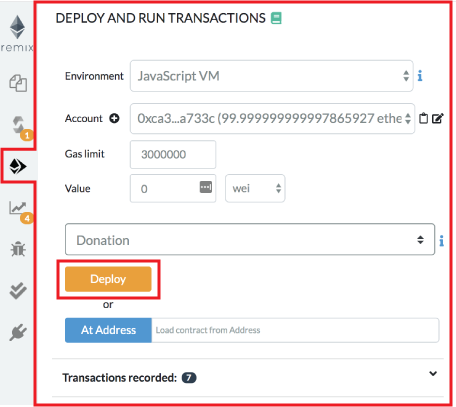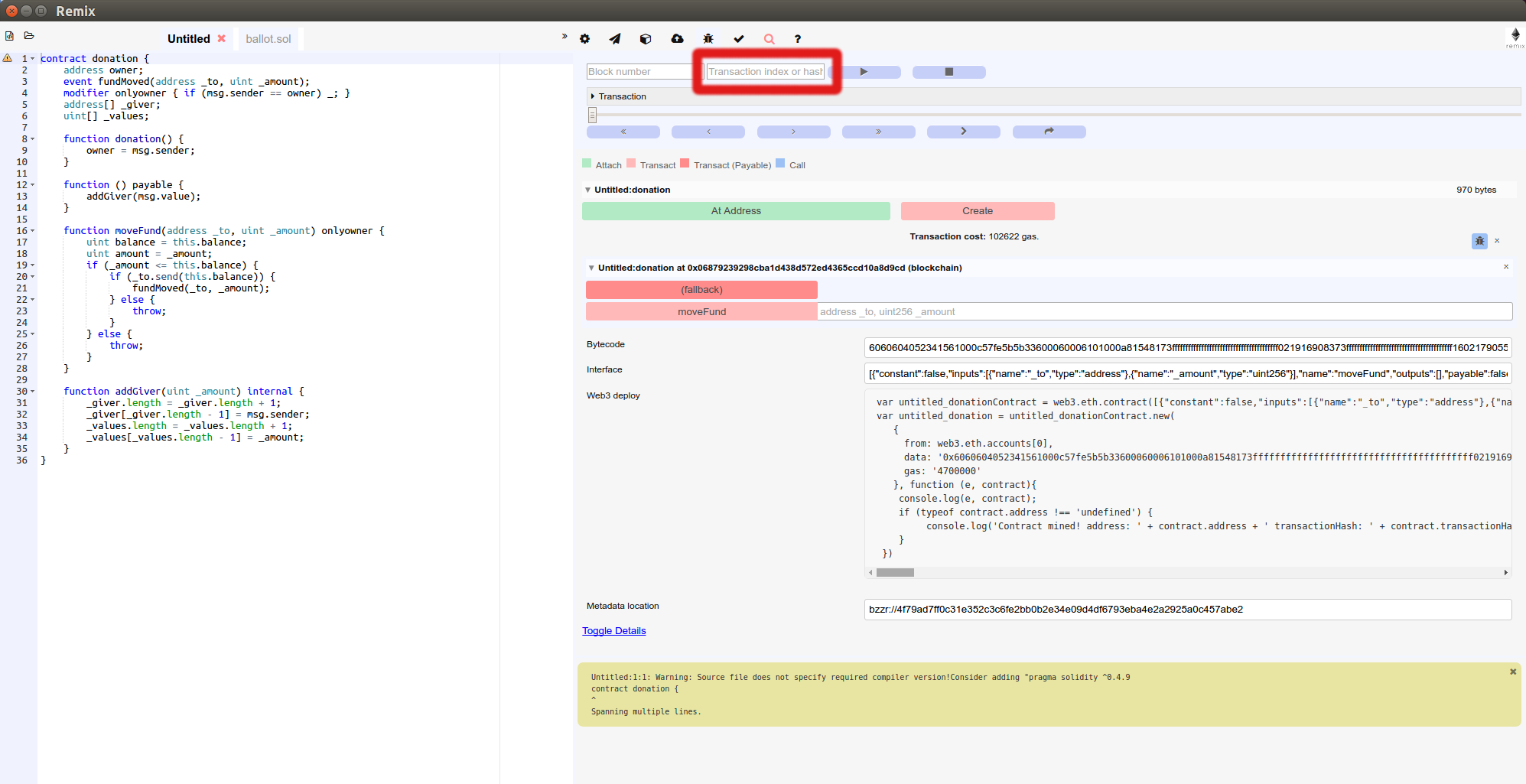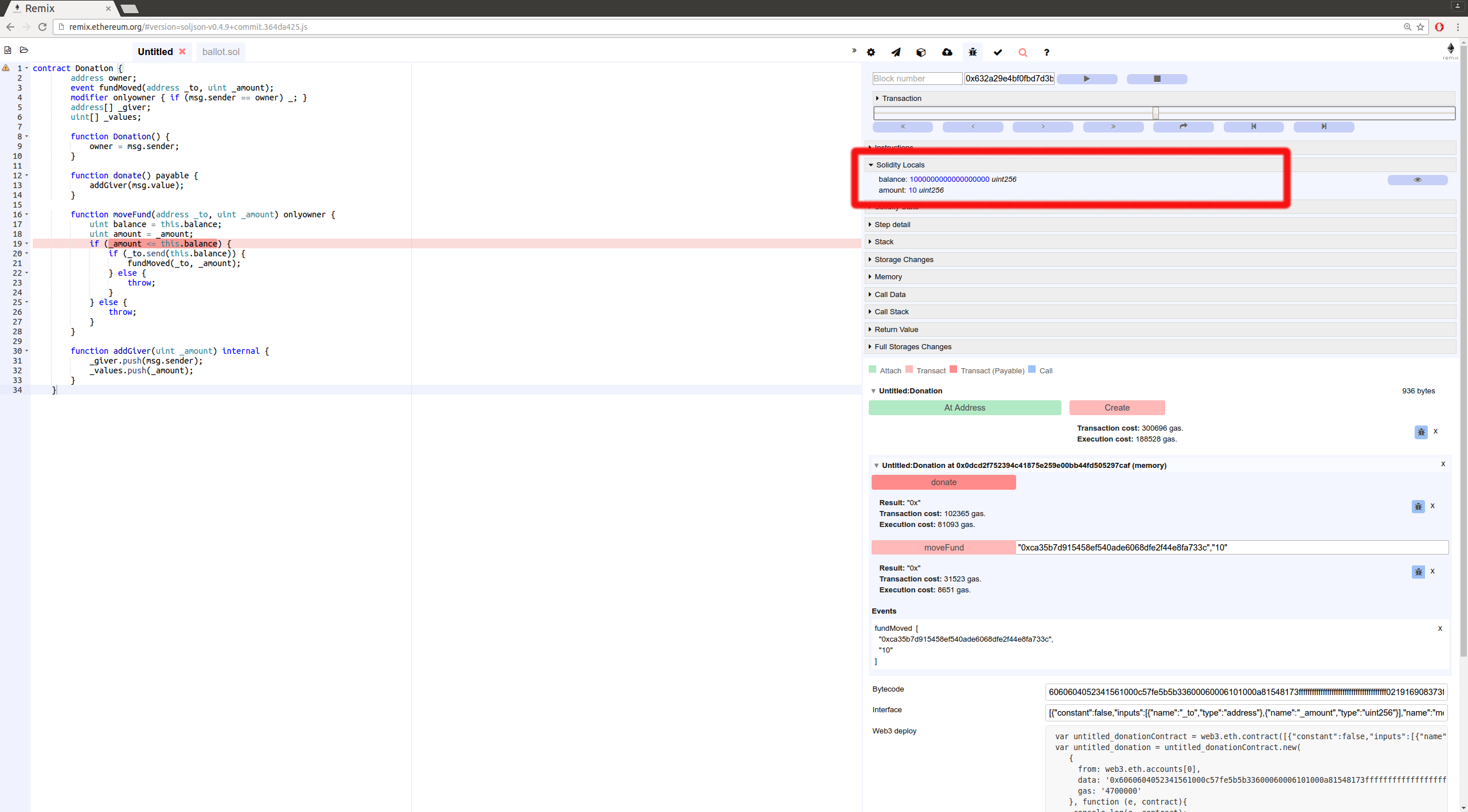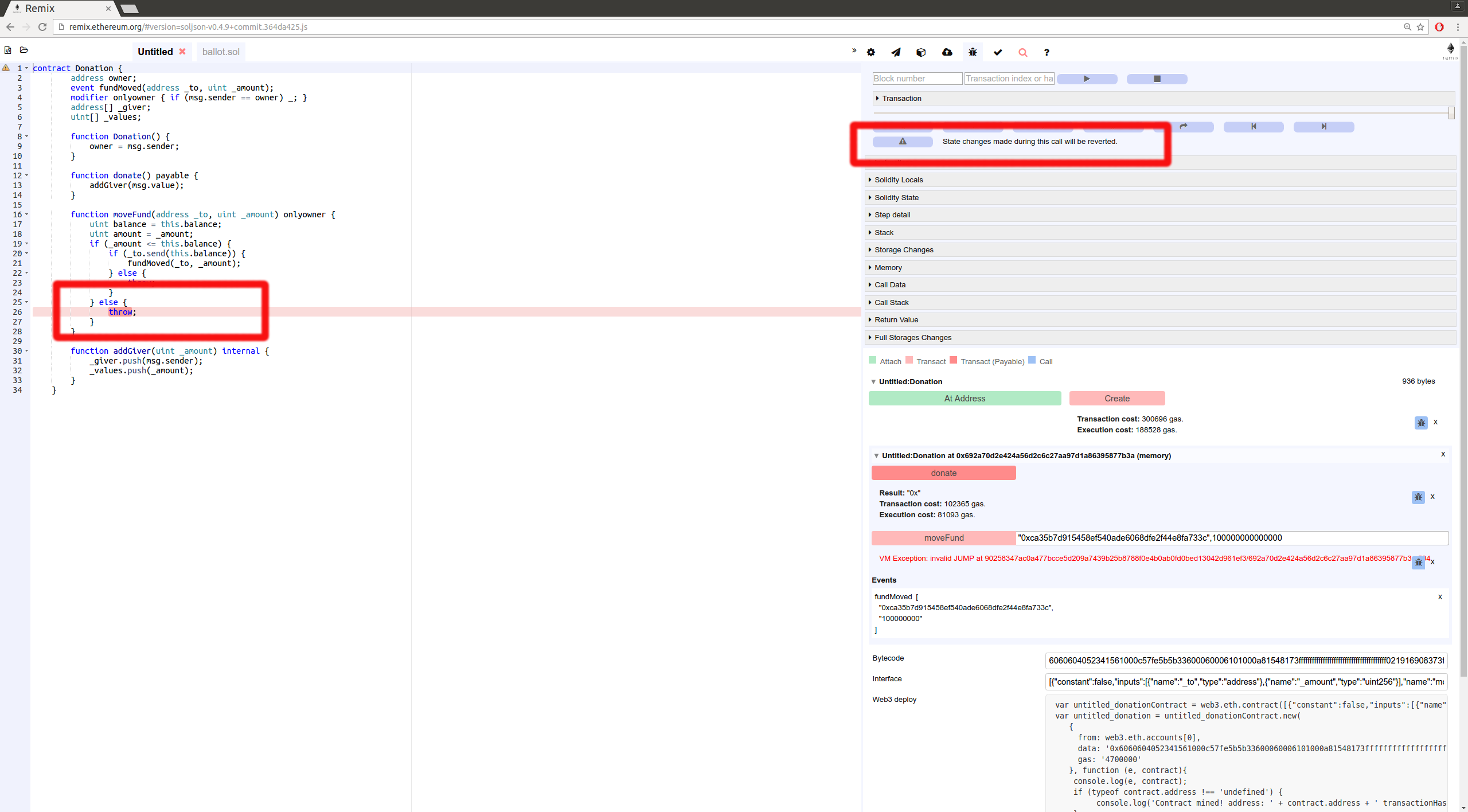6.8 KiB
Debugging transactions
There are two ways to start debugging, each one corresponds to a different use case.
- from the transaction log in the Terminal - use this when you are want to debug a "sucessful" transaction.
- from the Debugger - use this if you have a transaction hash or a block number with a transaction index.
Debug from the Transaction GUI -
Let's start with a basic contract (or replace this one by your own):
- create a blank file in the file explorer (by clicking the + icon) and give it a name.
- copy the code below.
- compile the code.
- click the Run & Deploy icon in the icon panel.
{.sourceCode .none} - RS why is this here?
pragma solidity >=0.5.1 <0.6.0;
contract Donation {
address owner;
event fundMoved(address _to, uint _amount);
modifier onlyowner { if (msg.sender == owner) _; }
address[] _giver;
uint[] _values;
constructor() public {
owner = msg.sender;
}
function donate() payable public {
addGiver(msg.value);
}
function moveFund(address payable _to, uint _amount) onlyowner public {
uint balance = address(this).balance;
uint amount = _amount;
if (_amount <= balance) {
if (_to.send(balance)) {
emit fundMoved(_to, _amount);
} else {
revert();
}
} else {
revert();
}
}
function addGiver(uint _amount) internal {
_giver.push(msg.sender);
_values.push(_amount);
}
}
For the purpose of this tutorial, we will run the JavaScript VM.
This simulates a custom blockchain. You could do the same using a proper backend node.
Let's deploy the contract:
Click the Deploy button
You'll see the deployed instance (AKA the udapp).
Then open it up (by clicking the caret).
We are going to call the Donate function and will send it ether.
To do this: in the value input box put in 2 and select Ether as the unit (and not wei like I did in the image below - well you could - it won't really change anything).
Then click the Donate button.
This will send Ether to the this function.
Because we are using the JavaScript VM, everything happens almost instantly. (If we had been using Injected Web 3, then we would have to need to approve the transaction, pay for gas and wait for the transaction to get mined.)
Remix displays information related to each transaction result in the terminal.
Check in the terminal where the transaction you just made is logged.
Click the debug button to start debugging it.
From the Debugger
Click the bug icon in the icon panel to get to the debugger in the side panel. If you don't see the bug icon go to the plugin manager and activate the debugger.
You can start a debug session by providing either a transaction hash
or a block number and transaction index.
To find a transaction hash
- go to a transaction in the terminal.
- Click a line with a transaction - to exand the log.
- Copy the transaction has locate there.
Then click on the start debugging button.
Using the debugger
The debugger allows one to see detailed informations about the transaction's execution. It uses the editor to display the location in the source code where the current execution is.
The transaction panel displays basic information about the current transaction.
The navigation part contains a slider and buttons that can be used to step through the transaction execution.
From the left to the right:
step over back, step into back, step into forward, step over forward, jump out (jump out of the current call), jump to the previous breakpoint, jump to the next breakpoint.
11 panels give detailed information about the execution:
Instructions
The Instructions panel displays the bytecode of the current executing contract- with the current step highlighted.
Important note: When this panel is hidden, the slider will have a courser granularity and only stop at expression boundaries, even if they are compiled into multiple EVM instructions. When the panel is displayed, it will be possible to step over every instruction, even those that refers to the same expression.
Solidity Locals
The Solidity Locals panel displays local variables associated with the current context.
Solidity State
The Solidity State panel displays state variables of the current executing contract.
Low level panels
These panels display low level informations about the execution:
- Stack
- Storages Changes
- Memory
- Call Data
- Call Stack
- Return Value (only if the current step is a RETURN opcode)
- Full Storages Changes (only at the end of the execution - display every storage change of every modified contract)
Reverted Transaction
A transaction could be reverted (because of an out of gas exception or
Solidity revert statement or because of a low level exception).
It is important to be aware of the exception and to locate where the exception is in the source code.
Remix will warn you when the execution throws an exception. The
warning button will jump to the last opcode before the exception
happened.
Breakpoints
The two last buttons from the navigation area are used to jump either back to the previous breakpoint or forward to the next breakpoint.
Breakpoints can be added and removed by clicking on the line number in the Editor.
When using debug session with breakpoints, the execution will jump to the first encountered breakpoint.
Important note: If you add a breakpoint to a line that declares a variable, it might be triggered twice: Once for initializing the variable to zero and second time for assigning the actual value. As an example, assume you are debugging the following contract:
(RS - what is the {.sourceCode .none} doing?)
{.sourceCode .none}
pragma solidity >=0.5.1 <0.6.0;
contract ctr {
function hid () public {
uint p = 45;
uint m;
m = 89;
uint l = 34;
}
}
And let's says that breakpoints are set for the lines
uint p = 45;
m = 89;
uint l = 34;
then clicking on Jump to next breakpoint will stop at the following
lines in the given order:
uint p = 45;(declaration of p)
uint l = 34;(declaration of l)
uint p = 45;(45 assigned to p)
m = 89;(89 assigned to m)
uint l = 34;(34 assigned to l)












